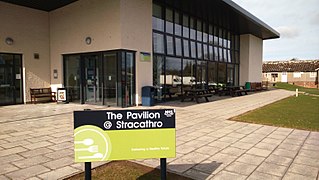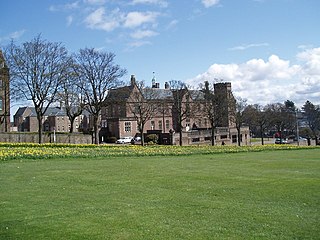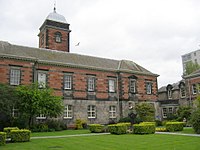History
Maryfield Hospital's origins can be traced to a poor hospital built in 1893 at the East Poorhouse, Dundee. The East Poorhouse had been built by the Parochial Board of Dundee in 1856 to the south of Clepington Road. [1] [2]
The hospital was run by Parochial Board (later known as Dundee Parish Council) as the Eastern Hospital. [3] Following the abolition of parish councils in Scotland in 1929, control passed to Dundee Town Council, under whose stewardship the hospital began to focus on the fields of maternity and childcare as Maryfield Hospital. [3]
Dr Jainti Dass Saggar played a key role in modernising the hospital via the provision of electro-cardiograms, bronchoscopes, and high-powered X-ray machines. [4]
From 1948, it came under the control of the National Health Service and along with other local hospitals was run by Dundee General Hospitals Board of Management. [1] [5] It eventually expanded to cover all of the site formerly occupied by the East Poorhouse. As a result, it became Dundee's second main hospital. [1]
From the late 1940s a number of senior doctors were transferred from Dundee Royal Infirmary to Maryfield to develop the hospital, including Jean Herring, a protégée of Margaret Fairlie, who became consultant in charge of the Gynaecology Department in 1949. [6] [7]
A new geriatric unit was opened at the hospital by Princess Margaret in 1957. [8]
Maryfield was also the site of a pioneering general hospital psychiatric unit, under the medical direction of Sir Ivor Batchelor. [9] In 1959 the psychiatric wards were amalgamated with Dundee District Asylum and Dundee Royal Asylum at Liff to form the combined Dundee Royal Mental Hospital at Liff. [1]
In the 1960s a world record was set at the hospital when a patient named Angus Barbieri spent 382 days between June 1965 and July 1966 without taking solid food. Barbieri survived by taking tea, coffee and soda water as well as vitamins. [10] [11] During that period, his weight declined from 214 to 80.74 kilograms (33 st 9.8 lb to 12 st 10.0 lb; 471.8 to 178.0 lb). [12]
Maryfield was used by the Medical School at University College Dundee, initially part of the University of St Andrews and later the University of Dundee. Professors Sir Ian Hill and Sir Donald Douglas secured building space at the hospital and Dundee Royal Infirmary for their famed research and clinical investigation into circulatory diseases and cardiology. [13]
Maryfield closed in stages between 1974 and 1976 following the opening of the larger and more modern Ninewells Hospital. [1] This came after some debate. There was an urgent need for better facilities for the teaching of medicine at Queen's College, Dundee and this required improvements be made to either Maryfield or Dundee Royal Infirmary (DRI) along with the building of a new hospital. [14] In 1960 a plan was approved to spend up to £800,000 redeveloping Maryfield by 1970, which assumed that it would be DRI that would close when Ninewells opened. [15] However, after much debate this plan was scrapped and it was decided to retain DRI and close Maryfield. [14] After the removal of the last patients, some of the buildings were retained by Tayside Health Board for use as administrative accommodation. [1]
Dundee is the fourth-largest city in Scotland with a population of around 150,000 people. It is situated on the north bank of the Firth of Tay on the east coast of the Central Lowlands of Scotland. The Dundee area has been settled since the Mesolithic with evidence of Pictish habitation beginning in the Iron Age. During the Medieval Era the city became a prominent trading port and was the site of many battles. Throughout the Industrial Revolution, the local jute industry caused the city to grow rapidly. In this period, Dundee also gained prominence due to its marmalade industry and its journalism, giving Dundee its epithet as the city of "jute, jam and journalism".

Ninewells Hospital is a large teaching hospital, based on the western edge of Dundee, Scotland. It is internationally renowned for introducing laparoscopic surgery to the UK as well as being a leading centre in developing fields such as the management of cancer, medical genetics and robotic surgery. Within the UK, it is also a major NHS facility for psychosurgery. The medical school was ranked first in the UK in 2009. The hospital has nursing and research links with the University of Dundee and is managed by NHS Tayside.

Sunnyside Royal Hospital was a psychiatric hospital located in Hillside, north of Montrose, Scotland. It closed in 2011 and is now used for housing.
Oswald Taylor Brown OBE, FRCP(Glasg), FRCP(Ed) was a Scottish consultant physician in geriatric medicine based in Dundee from 1951 until 1979. He is recognised as an early architect of geriatric care services in Scotland.

Tayside Children's Hospital is a children's facility which is attached to Ninewells Hospital in Dundee, Scotland. It delivers services to children who live in Dundee, Angus, Perth and Kinross and north east Fife and is managed by NHS Tayside.

NHS Tayside is an NHS board which forms one of the fourteen regions of NHS Scotland. It provides healthcare services in Angus, the Dundee City council area and Perth and Kinross. NHS Tayside is headquartered at Ninewells Hospital in Dundee; one of the largest hospitals in the world.

Perth Royal Infirmary is a district hospital in Perth. The Royal Infirmary serves a population of around 182,000 across the City of Perth and the wider Perth and Kinross area. It is managed by NHS Tayside.

Stracathro Hospital is a community hospital in Angus, Scotland. Established as a wartime Emergency Hospital Service facility during the Second World War, it was afterward developed as a District General Hospital. Since 2005 it has been the site of the Scottish Regional Treatment Centre.

Arbroath Infirmary is a hospital at the top of Rosemount Road in Arbroath serving the town and the greater area of Angus, Scotland. The hospital is managed by NHS Tayside.

Dundee Royal Infirmary, often shortened to DRI, was a major teaching hospital in Dundee, Scotland. Until the opening of Ninewells Hospital in 1974, Dundee Royal Infirmary was Dundee's main hospital. It was closed in 1998, after 200 years of operation.

Margaret Fairlie FRCOG FRCSE (1891–1963) was a Scottish academic and gynaecologist. Fairlie spent most of her career working at Dundee Royal Infirmary and teaching at the medical school at University College, Dundee. In 1940 she became the first woman to hold a professorial chair in Scotland.

King's Cross Hospital, often shortened to King's Cross is a hospital in Dundee, Scotland. It is managed by NHS Tayside.
Royal Victoria Hospital, Dundee, is a hospital in Dundee, Scotland. It was formerly known as the Victoria Hospital for Incurables. Today, the hospital is primarily dedicated to medicine for the elderly. It is managed by NHS Tayside.
The University of Dundee School of Medicine is the school concerned with medical education and clinical research at the University of Dundee in Scotland. In 1967, Dundee's medical school became independent in its own right having started in 1889 as a joint venture between the University of St Andrews and University College Dundee. In 1974 the medical school moved to a large teaching facility based at Ninewells Hospital in the west of Dundee. The School of Medicine now encompasses undergraduate, postgraduate, specialist teaching centres and four research divisions.

Jainti Dass Saggar was an Indian-born doctor in Dundee, Scotland, who in 1936 became the first non-white local authority councillor in Scotland. He served 18 years as a Labour Party councillor and was one of Dundee's longest-serving council members.

Bridge FM is an independent hospital radio station which is currently based in Ninewells Hospital in Dundee, Scotland that was launched in 1952. The radio station airs 24 hours a day with a range of music and talk show programmes.
James Frederic Riley FRSE FRCSE was a 20th-century English physician, radiologist and cancer specialist. His identification that the mast cell was the main producer of histamine in the human body resulted in his being made a visiting professor at the University of Montreal and to his being awarded the Claude Bernard Medal for medical achievement. He was one of the first to identify the link between mast cells and asthma and the potential use of antihistamines in this field.
The Carseview Centre is a mental health unit in the grounds of Ninewells Hospital in Dundee, Scotland. It is managed by NHS Tayside.

The Royal Dundee Liff Hospital, previously known as Dundee Lunatic Asylum and Dundee Royal Lunatic Asylum, was a mental health facility originally established in 1812 in Dundee, Scotland. It was originally located in premises in Albert Street Dundee, but later moved out of the town to new buildings in the nearby parish of Liff and Benvie. Buildings at Liff included Greystanes House, which was the main building, and, Gowrie House, which was the private patients' facility. Both Grade B listed buildings.

The timeline of Dundee history shows the significant events in the history of Dundee, Scotland.
















